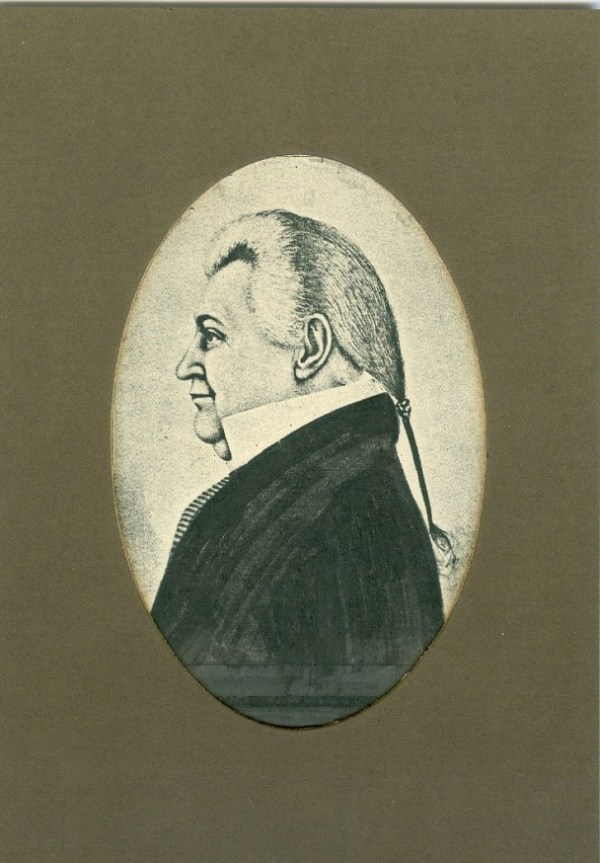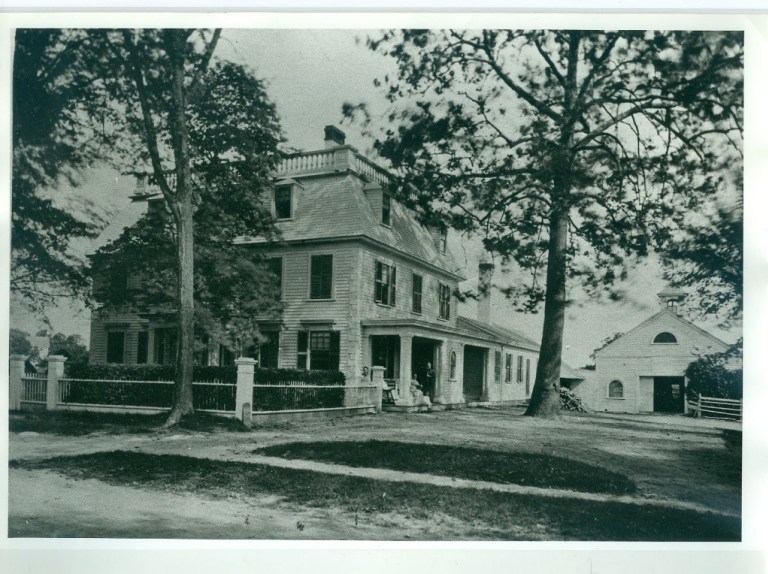In every town, in every era, there is a person who stands out for his/her commitment to community service. Jonathan Maynard (1752-1835) was Framingham’s leading citizen following the Revolutionary War. Jonathan was the second son of Jonathan and Martha (Gleason) Maynard. The Maynards lived on Salem Street (now called Salem End Road) in Framingham Centre.

When the Revolutionary War began, Maynard was within days of completing his studies at Harvard College. He immediately left Harvard to enlist in the Framingham Company attached to Col. John Nixon’s regiment. Eight weeks later, he saw combat in the Battle of Bunker Hill. During the evacuation of Boston by the British in March of 1776, he was removed to upstate New York. He fought in most of the battles in that area including Stillwater and Saratoga.
During the winter of 1777-78, while stationed in Albany, Maynard and five other Framingham men in General John Nixon’s brigade joined the Freemasons, a fraternal organization. This group included Col. Thomas Nixon, Capt. Peter Cloyes, Lieut. Samuel Frost, Lieut. Trowbridge, and Luther Trowbridge. Legend has it that on May 30, 1778, while on a reconnaissance or foraging mission, Maynard and a few other soldiers were attacked and captured by a band of Mohawks, allies of the British. All of the soldiers were killed by the Mohawks except for Maynard. He was brought back to their leader, Chief Joseph Brant. Chief Brant had been educated in Britain, spoke English, and as luck would have it, was also a Freemason. Chief Brant sentenced Maynard to be burned at the stake. Just as he was to be executed, Maynard gave the Freemason hand signal for extreme peril which the Chief recognized. Brant stopped the execution! He then sent Maynard to Canada as a prisoner of war for the next thirty one months. Upon his release on December 26, 1780, Maynard returned to his company at West Point, and was promoted to the rank of Captain. On November 19, 1781, after the battle of Yorktown, he resigned his commission and returned to his hometown of Framingham.
Once home, Maynard settled into civilian life. He first found employment as a school teacher. And then on May 30, 1784, he married Lois Eaton, the oldest child of Jonas and Lois (Goodnow) Eaton. The Maynards made their home in Framingham Centre in the partially finished Patterson House, which had been moved from the Nobscot area to Pleasant Street.
Maynard became very involved in town affairs. He was appointed Justice of the Peace. He served a three year term as a town selectman, and then a two year term as the town clerk. In 1810, he was appointed to be Framingham’s first postmaster, a position he held for twenty-three years.
Maynard then took his political ambitions to the state level. He was elected to the state legislature and served as state representative for fifteen years, 1790-1805. On January 14, 1800, W. Winthrop resigned his seat in the Senate, and Maynard was tapped as his replacement. He served in the state Senate until 1807. Maynard served concurrent terms as representative and senator for the years 1801-1805.

Maynard found something lacking in his civilian life in Framingham. It was the comradery of the Masonic meetings. He and the others who had joined the Freemasons in Albany decided to establish a lodge in their hometown. Maynard gathered eleven men (the minimum number needed to establish a lodge) and petitioned the Grand Lodge of Massachusetts for a charter. The charter, signed by Paul Revere, the Grand Master of the Grand Lodge of Massachusetts, was granted on June 9, 1795. Among these eleven charter members eight were from Framingham and three from surrounding towns. The Middlesex Lodge of Freemasons held their meetings at Maynard’s home for the first twelve years with Maynard as the Grand Master. Maynard was an active Freemason for fifty-eight years, attending his last meeting just months before his death.
Captain Jonathan Maynard died on July 17, 1835 and is buried in the Old Burying Ground in Framingham Centre. To acknowledge his service and devotion to the town of Framingham, an elementary school built on Vernon Street in 1915 (now part of Framingham State University) and a road in Framingham Centre are named in his honor. The area in Framingham Centre extending from the First Baptist Church west along Pleasant Street to the railroad tracks, including property on Maynard Road was designated as the Jonathan Maynard Historic District by the 1994 Annual Town Meeting.
Facts
Birth date: May 22, 1752
The Maynard House is located at 113 Pleasant Street.
First officers of the Framingham Grand Lodge: Capt. Jonathan Maynard, Master; Capt. Peter Cloyes, Senior Warden; Barzaiiai Bannister, Junior Warden; Capt. Samuel Frost, Secretary; Major Andrew Brown, Treasurer; Col. Thomas Nixon, Senior Deacon; Thomas Buckland, Jr., Deacon.
Bibliography
Brownell, John H., ed. “Life Story of Jonathan Maynard.” The American Tyler-Keystone: Devoted to Freemansonry and its Concerdant Others. vol. 14, no. 2, July 15 1899, pp. 42-43. Google Books. https://books.google.com/books?id=9R_nAAAAMAAJ&pg=PA42&dq=life+of+jonathan+maynard+american+tyler-keystone&hl=en&sa=X&ved=0ahUKEwiZ9M2i5tPdAhWLct8KHZdtDN4Q6AEIJzAA#v=onepage&q=lifeofjonathanmaynardamericantyler-keystone&f=false Accessed 24 Sept. 2018.
City of Framingham, Historic District Commission. “613 Pleasant Street Preliminary Report (pdf).” City of Framingham website. https://www.framinghamma.gov/1555/Historic-District-Commission Accessed 21 Dec. 2018.
Coolidge, Charles W. “Brief Sketch of His Military and Masonic Life.” The Tribune. 01 Apr. 1898. Pp.4+”The following democratic republican senators are probably chosen by the people.” National Intelligencer and Washington Advertiser [Washington, District Of Columbia] 20 Apr. 1804. 19th Century U.S. Newspapers. http://find.galegroup.com.ezproxy.bpl.org/ncnp/infomark.do?&source=gale&prodId=NCNP&userGroupName=mlin_b_bpublic&tabID=T003&docPage=article&searchType=BasicSearchForm&docId=GT3017437465&t
Herring, Stephen. Framingham: An American Town. Framingham Historical Society, The Framingham Tercentennial Commission, 2000.
“Joseph Brant”. Encyclopædia Britannica. 2018. Encyclopædia Britannica Online. Accessed 28 Sept. 2018.
“Maynard, Jonathan Captain.” The State Legislative Biographical card file. State Library of Massachusetts, Reference Dept.
“Post Office Appointments.” National Intelligencer [Washington, District Of Columbia] 8 Dec. 1810. 19th Century U.S. Newspapers. http://find.galegroup.com.ezproxy.bpl.org/ncnp/infomark.do?&source=gale&prodId=NCNP&userGroupName=mlin_b_bpublic&tabID=T003&docPage=article&searchType=BasicSearchForm&docId=GT3017453105&type=multipage&contentSet=LTO&version=1.0 Accessed 23 Sept 2018.
Temple, Josiah H. History of Framingham, Massachusetts, 1640-1885. A special Centennial Year reprinting of the 1887 edition. New England History Press, 1988.